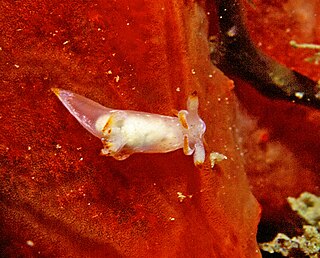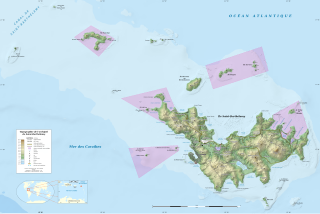
SpongeBob SquarePants is the protagonist of the eponymous American animated television series. Voiced by Tom Kenny, he is characterized by his optimism and childlike attitude. SpongeBob is commonly seen hanging out with his friend Patrick Star, working at the Krusty Krab, with his neighbor Squidward Tentacles and attending Mrs. Puff's Boating School, while getting involved in zany hijinks along the way. SpongeBob also has a pet snail called Gary.

An oligopeptide, is a peptide consisting of two to twenty amino acids, including dipeptides, tripeptides, tetrapeptides, and other polypeptides. Some of the major classes of naturally occurring oligopeptides include aeruginosins, cyanopeptolins, microcystins, microviridins, microginins, anabaenopeptins, and cyclamides. Microcystins are best studied because of their potential toxicity impact in drinking water. A review of some oligopeptides found that the largest class are the cyanopeptolins (40.1%), followed by microcystins (13.4%).

A tripeptide is a peptide derived from three amino acids joined by two or sometimes three peptide bonds. As for proteins, the function of peptides is determined by the constituent amino acids and their sequence. In terms of scientific investigations, the dominant tripeptide is glutathione (γ-L-Glutamyl-L-cysteinylglycine), which serves many roles in many forms of life.

SpongeBob SquarePants is an American animated television series created by marine science educator and animator Stephen Hillenburg that first aired on Nickelodeon as a sneak peek after the 1999 Kids' Choice Awards on May 1, 1999, and officially premiered on July 17, 1999. It chronicles the adventures of the title character and his aquatic friends in the underwater city of Bikini Bottom. The series received worldwide critical acclaim, and had gained popularity by its second season. As of 2019, the series is the fifth-longest-running American animated series. Its popularity made it a multimedia franchise, the highest rated Nickelodeon series, and the most profitable intellectual property for Paramount Consumer Products. By 2019, it had generated over $13 billion in merchandising revenue.
A tetrapeptide is a peptide, classified as an oligopeptide, since it only consists of four amino acids joined by peptide bonds. Many tetrapeptides are pharmacologically active, often showing affinity and specificity for a variety of receptors in protein-protein signaling. Present in nature are both linear and cyclic tetrapeptides (CTPs), the latter of which mimics protein reverse turns which are often present on the surface of proteins and druggable targets. Tetrapeptides may be cyclized by a fourth peptide bond or other covalent bonds.
A depsipeptide is a peptide in which one or more of its amide, -C(O)NHR-, groups are replaced by the corresponding ester, -C(O)OR-. Many depsipeptides have both peptide and ester linkages. Elimination of the N–H group in a peptide structure results in a decrease of H-bonding capability, which is responsible for secondary structure and folding patterns of peptides, thus inducing structural deformation of the helix and β-sheet structures. Because of decreased resonance delocalization in esters relative to amides, depsipeptides have lower rotational barriers for cis-trans isomerization and therefore they have more flexible structures than their native analogs. They are mainly found in marine and microbial natural products.

4-PPBP is a neuroprotective cyclic amine which binds to sigma receptors.
Polymastia fusca is a species of sea sponge belonging to the family Polymastiidae. It is found in shallow subtidal habitats in the far north of North Island, New Zealand.

The giant barrel sponge is the largest species of sponge found growing on Caribbean coral reefs. It is common at depths greater than 10 metres (33 ft) down to 120 metres (390 ft) and can reach a diameter of 1.8 metres. It is typically brownish-red to brownish-gray in color, with a hard or stony texture.

Xestospongia testudinaria is a species of barrel sponge in the family Petrosiidae. More commonly known as Giant Barrel Sponges, they have the basic structure of a typical sponge. Their body is made of a reticulation of cells aggregate on a siliceous scaffold composed of small spikes called spicules. Water is taken into the inner chamber of the sponge through ostia. Flagellated choanocytes line the inner chamber and help generate water currents through the sponge.

BQ-123, also known as cyclo(-D-Trp-D-Asp-Pro-D-Val-Leu-), is a cyclic pentapeptide that was first isolated from a fermentation broth of Streptomyces misakiensis in 1991. NMR studies indicate that the polypeptide backbone consists of a type II beta turn and an inverse gamma turn. The side-chains adopt different orientations depending on the solvent used. The proline carbonyl oxygen atom located at the onset of a beta turn is a sodium ion binding site. It has a high affinity for sodium ions and can coordinate up to three of them. Studies have shown that BQ123 is effective in reversing Ischemia-induced acute renal failure, and it has been suggested that this might be because BQ123 increases reabsorption of sodium ions in the proximal tubule cells.

Aciculitins are antifungal cyclic peptides isolated from a marine sponge. There are 3 Aciculitins that are isolated from the Lithistid sponge Aciculites orientalis that differ by their homologous lipid residues.

Lacking an immune system, protective shell, or mobility, sponges have developed an ability to synthesize a variety of unusual compounds for survival. C-nucleosides isolated from Caribbean Cryptotethya crypta, were the basis for the synthesis of zidovudine (AZT), aciclovir (Cyclovir), cytarabine (Depocyt), and cytarabine derivative gemcitabine (Gemzar).

Trapania fusca is a species of sea slug, a dorid nudibranch, a marine gastropod mollusc in the family Goniodorididae.
CNMamide (CNMa) is a cyclic neuropeptide identified by computational analysis of Drosophila melanogaster protein sequences and named after its C-terminal ending motif. A gene encoding CNMa was found in most arthropods and comparison among the precursor sequences of several representative species revealed high conservation, particularly in the region of the predicted mature peptide. Two conserved cysteine residues enveloping four amino acids form a disulfide bond and were shown to be important for binding of the peptide to its receptor. Expression of CNMa was confirmed in the larval and adult brain of D. melanogaster but the function of the peptide has not been elucidated yet.

Nature Reserve of Saint Barthélemy is a nature reserve of Saint Barthélemy, French West Indies, an overseas collectivity of France.
Stylissa caribica is a species of sponge. Stylisins 1 and 2 are antimicrobial cyclic heptapeptides which have been isolated from this species.

Acanthella dendyi is a marine sessile filter-feeder sponge in the family Dictyonellidae, first described by Patricia Bergquist in 1970 as Phakellia dendyi

Bubaridae is a family of sponges belonging to the order Bubarida. It has a cosmopolitan distribution.

Phakellia is a genus of sponges belonging to the family Bubaridae. The genus has a cosmopolitan distribution.













